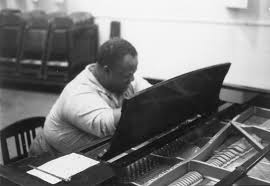Blues part 2 – Meade Lux Lewis
The second in a series of five solo explorations of the blues, recorded at the very first Blue Note Records session. Our transcription is very detailed with all important dynamic and articulation markings.
- Recording: Albert Ammons - Meade Lux Lewis - The First Day
- Recorded on: January 6, 1939
- Label: Blue Note (7-98450-2)
- Concert Key: C
- Vocal Range: , to
- Style: Swing (slow)
- Piano - Meade Lux Lewis
Video
- Description
- Historical Notes
- Solos
- Piano Corner
- Bass Corner
- Drum Corner
- Guitar Corner
- Inside & Beyond
- Minus You
The first chorus of part 2 begins very simply in the right hand, with a two-note theme in which the first note is held out through the measure. The left hand starts with the same simple 2-feel figures heard in part 1, but in the beginning of the second chorus the left hand has sustained middle-register chords. This chorus has the right hand alternating accented octaves in triplets and minor third tremolos, with a "break" in the fourth measure leading back to the texture of the first chorus. The third chorus introduces a rhythmic block-chord figure in the right hand, repeated for five measures; block chords reappear later in the chorus as well. In the fourth chorus, the right hand goes into a lower register for some flowing melodic lines with a distinctly vocal quality, very expressive. The range of both hands goes up in the fifth chorus, but the dynamic goes down; this chorus begins with quiet chords in triplets in the right hand and sustained chords in the left, while at the fifth measure the left hand switches to short quarter note chords. Tremolo chords, which were introduced toward the ends of the third and fifth choruses, are highlighted in the first three measures of the sixth chorus; this chorus has walking bass in the left hand and comes to a chordal end in the tenth measure.
Cdim7 is used as a passing chord to and from C7 at the beginning of the second chorus, a common boogie-woogie device. The rhythmic chordal figure of the third chorus is based on a descending sequence Lewis uses frequently, which appears fully in the tenth measure of the second chorus.
"The First Day."
These solos are played with a rolling swing feel, and we have notated swing eighth notes in triplets in many places where the rhythmic feel is dominated by triplets.
Related Songs
Email Send Blues part 2 to a friend

Meade Lux Lewis
September 4, 1905 – June 7, 1964
Born Meade Anderson Lewis in Chicago, Meade "Lux" Lewis is one of the most important early jazz pianists. When he was a child, his father insisted that Meade learn violin. After his father died, he took up piano at the age of 16. He learned by listening to pianist Jimmy Yancey and received no training. Despite this, his considerable skill earned him the attention of the Chicago music scene, and in addition to securing local gigs, he made his recording debut in 1927 with "Honky Tonk Train Blues" for Paramount Records. Read more...

